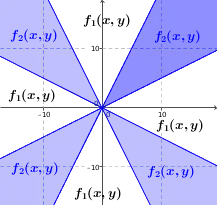Preliminary analysis
WLOG $a=b=0$. Now assume both limits exist. Thus define
$$
\begin{align}
\lim_{x\to 0}\lim_{y\to 0} f(x,y)&=\nu\\
\lim_{y\to 0}\lim_{x\to 0} f(x,y)&=\omega
\end{align}
$$
Then there exists a neighbourhood of $(0,0)$ small enough for it to be possible for $(x,y)$ in this neighbourhood to define $f_y,f_x$ as
$$
f_y(x)=
\begin{cases}
\nu&&&\text{for }x=0\\
\text{ }\\
\lim_{y\to 0}f(x,y)&&&\text{else}
\end{cases}
$$
and a similar definition of $f_x$ where $f_x(0)=\omega$ and $f_x(y)=\lim_{x\to 0}f(x,y)$ for $y\neq 0$. These functions are defined by pointwise limits and may have nothing to do with $f(x,y)$ along the lines $x=0$ and $y=0$. They are both continuous at $0$ by our assumption. They do not have to be continuous anywhere else. For now that is all we know.
Suppose the limits are unequal
Assume $\nu\neq\omega$. Since $f_y(x)$ is continuous at $x=0$ we know that for $x\neq 0$ small enough we can have $f_y(x)$ closer to $\nu$ than $\varepsilon=0.2|\nu-\omega|$. Fixing such $x$, choosing $y$'s small enough will ensure in addition to that that $f(x,y)$ is closer to $f_y(x)$ than this $\varepsilon$ too. This can be obtained for all $(x,y)$ in a sufficiently small neighbourhood of the line $x=0$ near $(0,0)$. So in this neighbourhood we have $f(x,y)$ closer to $\nu$ than $0.4|\nu-\omega|$ except for possibly on the line itself. Similarly we may find a neighbourhood of the line $y=0$ near $(0,0)$ where $f(x,y)$ is closer to $\omega$ than $0.4|\nu-\omega|$. Both these neighbourhoods will have a non-empty intersection with any neighbourhood of $(0,0)$.
Conclusion: In the case of $\nu\neq\omega$ we can always find function values further appart than $0.2|\nu-\omega|$. This means that the limit $\lim_{(x,y)\to(0,0)}f(x,y)$ cannot exist.
Suppose the limits are equal
The limit may still not exist
Now if $\nu=\omega$ we can still not be sure that the limit $\lim_{(x,y)\to(0,0)}f(x,y)$ will exist. One example is given in an answer to the question linked to by Git Gud in the comment section. As another example, one could simply choose any two continuous functions $f_1(x,y)$ and $f_2(x,y)$ with $f_1(0,0)=\nu$ and $f_2(0,0)\neq\nu$ and define
$$
f(x,y)=
\begin{cases}
\text{anything}&&&\text{at }(0,0)\\
f_2(x,y)&&&\text{for }|x/y|\in[0.5,2]\\
f_1(x,y)&&&\text{otherwise}
\end{cases}
$$

The the limit along the axes will be $\nu$, but the function as a whole has no limit at $(0,0)$.
If the limit exists
If also the limit $\lim_{(x,y)\to(0,0)}f(x,y)$ exists then it has to equal $\nu=\omega$ due to similar reasons in the argument that the limit cannot exist if $\nu\neq\omega$. We can find neighbourhoods of the lines $x=0$ and $y=0$ so that $f(x,y)$ is arbitrarily close to $\nu=\omega$ and these neighbourhoods will still remain in any intersection with a however small neighbourhood of $(0,0)$. So if the limit exists it has to equal the other two.
Closing remark
Though I somehow feel that my answer here repeats (or maybe elaborates upon) some of the ideas given in the linked-to-question, and though my analysis is mostly an abstract reformulation of the assumptions the OP gave, I still think and hope it adds a few details and distinctions into cases that others may find interesting too.
